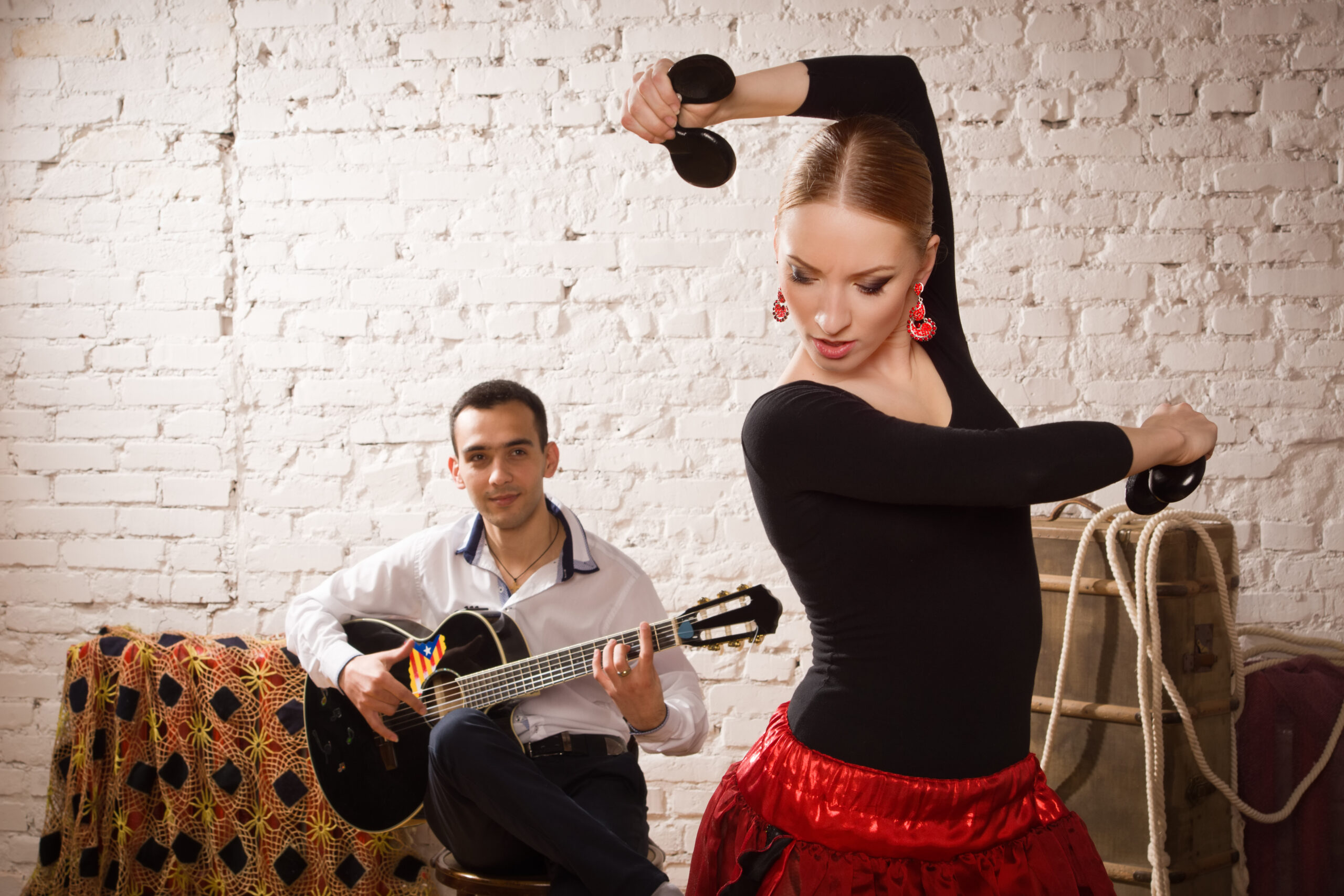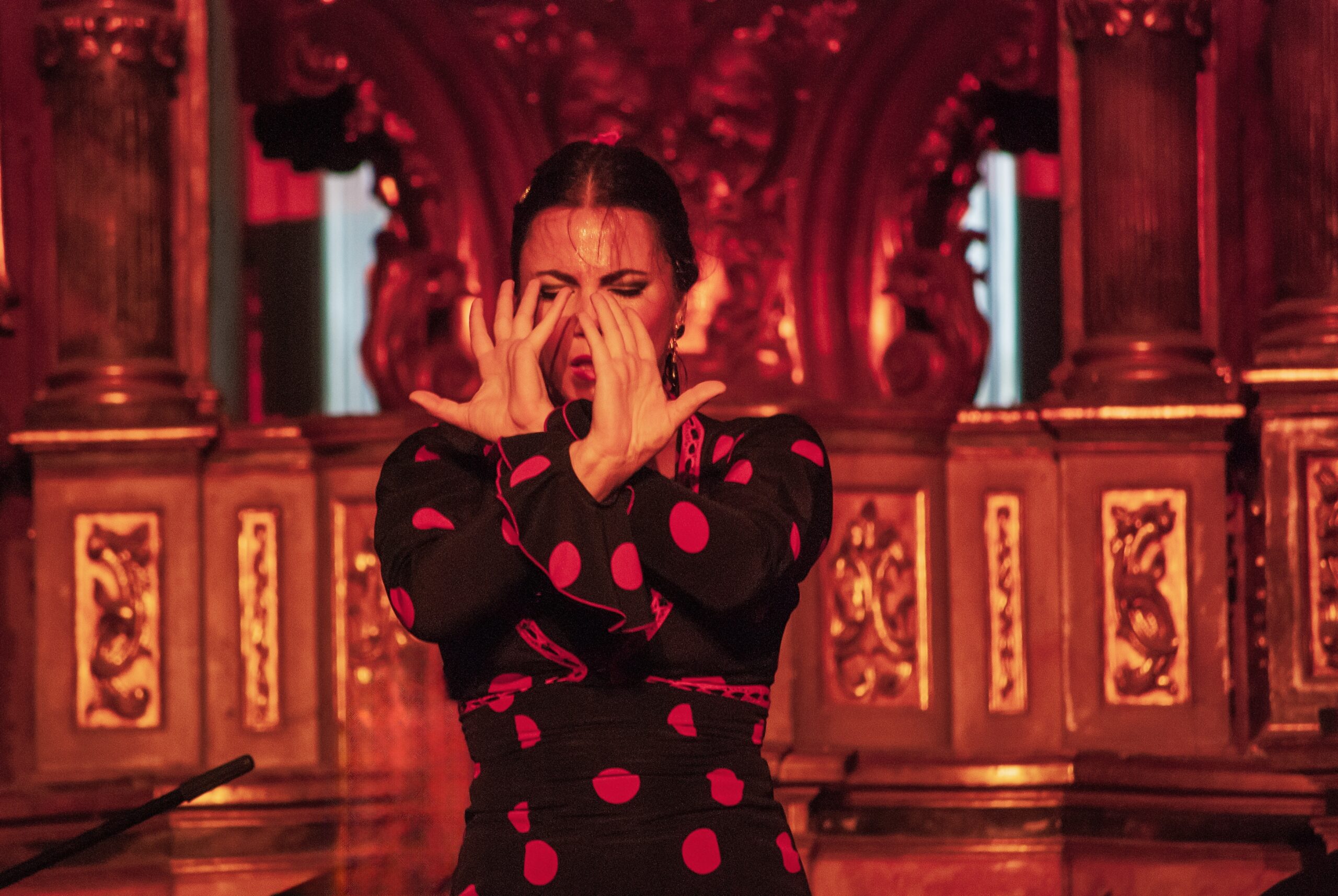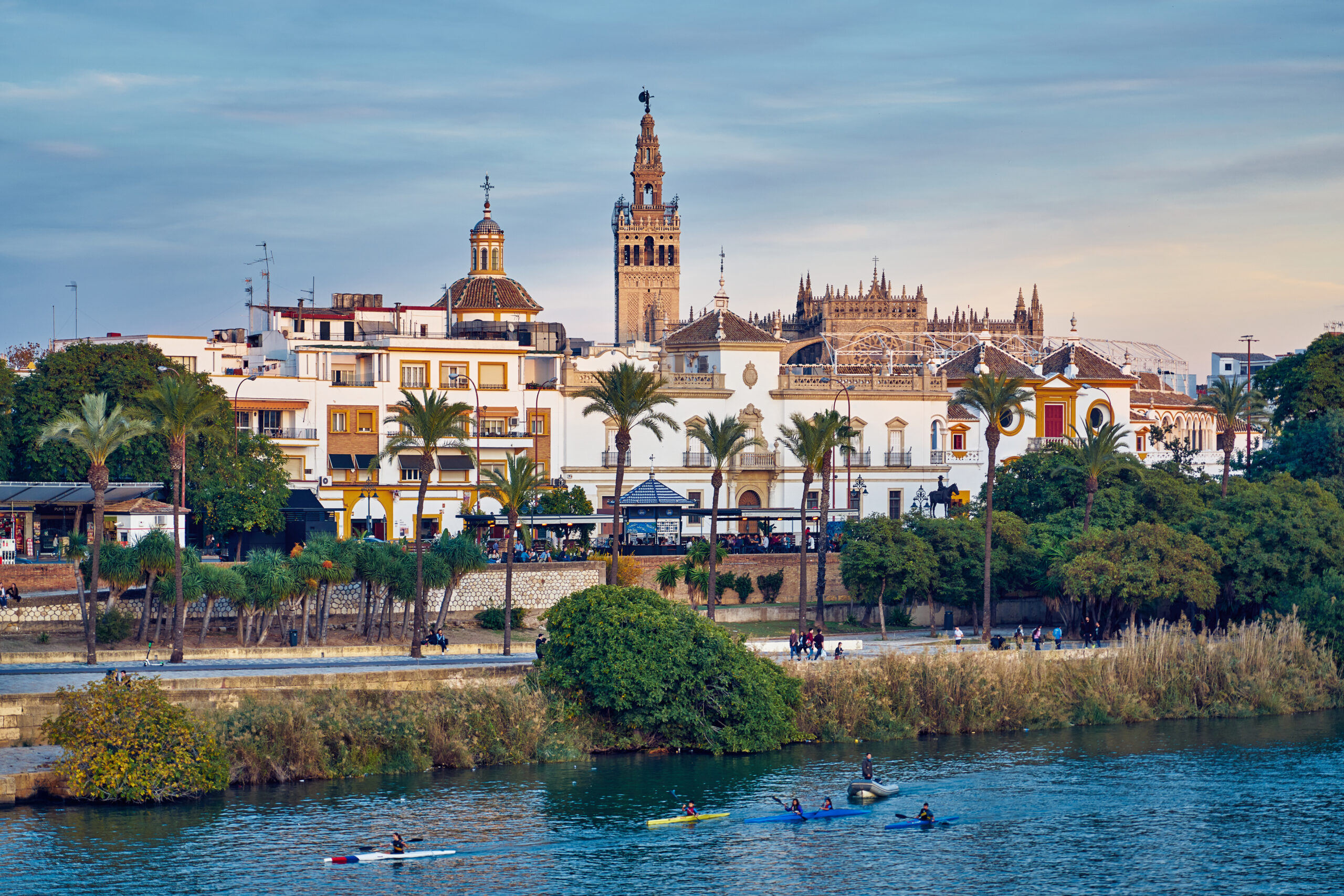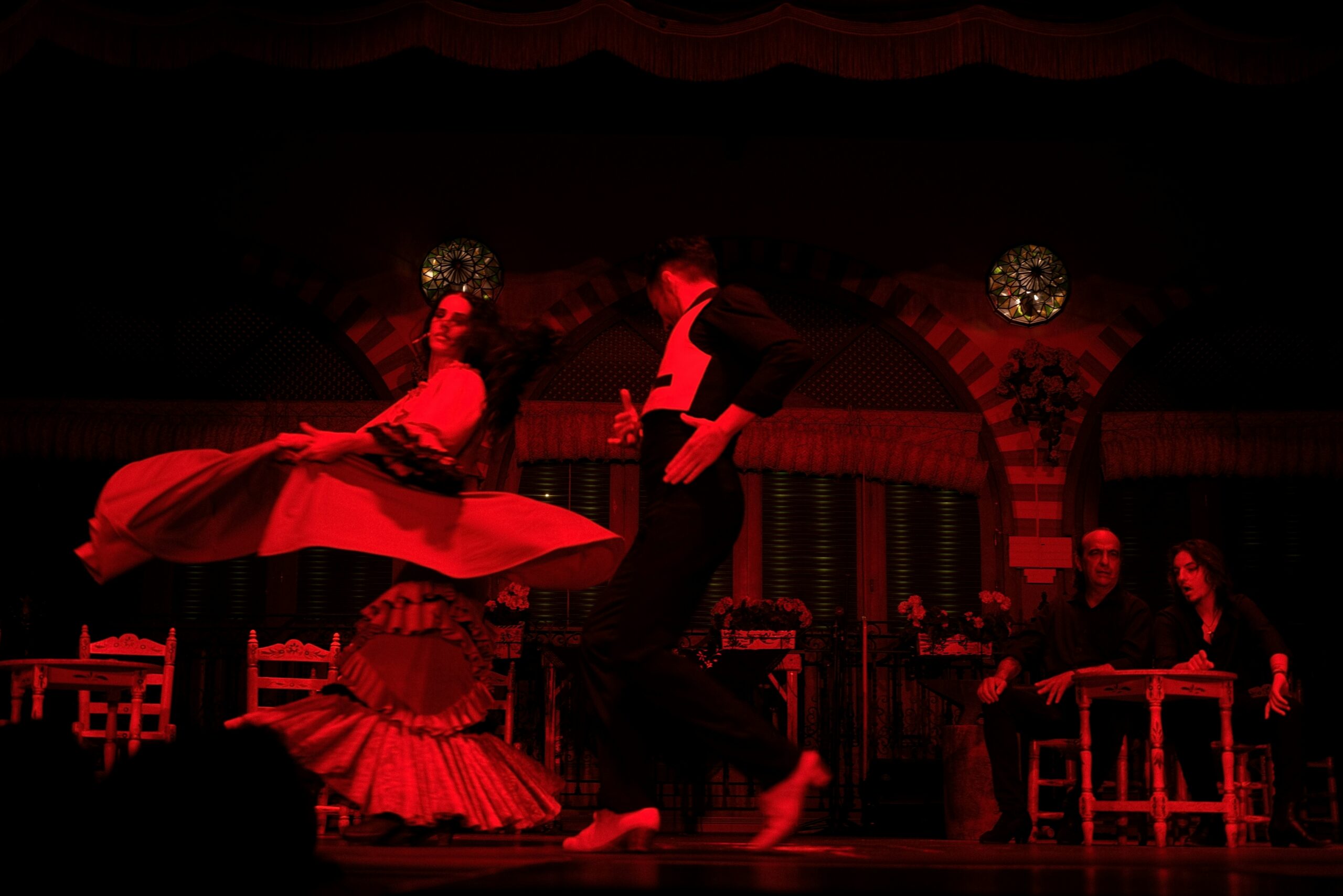Flamenco Decoded: Spain’s Art of Raw Human Emotion
You can feel the electricity and tension even on the empty stage. Your eyes perk up at the sound of heels striking the floor as raw, unfiltered emotion fills the space as the room holds its breath. The guitar’s intricate notes dance alongside the singer’s trembling voice, while the dancer moves to their hypnotic melody. Around you, everyone is silent in awe. You don’t just watch flamenco – it happens to you.
What you’re witnessing is not just entertainment – it’s centuries of Spanish soul laid bare. Equal parts catharsis, storytelling, and spiritual release. An art that turns pain into beauty.
While it’s a poignant, intense, world-renown art form (UNESCO-recognized to boot!), there are lots of common misconceptions: flamenco is not tango (which is Argentinian and usually partnered), it’s not always fast and fiery, and it’s not always ruffled dresses and spectacle.
Authentic flamenco isn’t just performance, it’s personal expression – a conversation between the artist and the audience, where you’re privy to the innermost feelings pouring out of the person’s soul. And while bailaoras (female dancers) often capture attention, male bailaors bring forth compelling intensity too. Both channel raw power through precise footwork and dramatic arm movements. Flamenco isn’t performed: it’s lived, breathed, and felt – and you’re also an active participant!
Born from the fusion of Romani, Moorish, and Andalusian cultures, for centuries, flamenco was the voice of the voiceless, emerging from Spain’s most marginalized and persecuted peoples.

Behind the passion lies a complex art form:
The Holy Trinity: Cante, Baile, Toque
Three elements make for any authentic flamenco:
- Cante (song) – Raw, unrestrained voice, telling stories of love, loss, joy. Needs breath control and emotional projection.
- Baile (dance) – Translations of emotion into physical movement. Requires physical stamina and precise footwork.
- Toque (guitar playing) – The heartbeat and foundation that drives the art form. Demands total focus on complex fingering and rhythm.
The most authentic flamenco will have you seeing one person per element. Which is why you rarely see someone singing while executing the lightning-fast footwork of zapateado. This complete devotion to a single element allows each performer to pour their entire being into their craft. A true performance feels like watching someone’s soul stripped completely bare, aided by this holy trinity of flamenco.

Reading Flamenco’s Secret Language
Every gesture has meaning – from the simple arch of the eyebrow to the way the fingers curl. To truly understand what you’re seeing, you need to recognize the different emotional languages flamenco speaks:
In flamenco, palos refer to different styles or sub-genres – each with their own distinct rhythms, structure and mood. There are over 50 palos, which are categorized by their patterns, themes, and performance contexts.
A few examples:
- Soleá: Deep, serious, often expression of sorrow or introspection.
- Alegrías: Joyful, light, celebrating happiness and festivity.
- Bulerías: Fast-paced and playful, often performed at the climax.
- Fandango: Rooted in folk traditions, often romantic and lyrical.
Each palo feels like and expresses something completely different, like switching from a symphony to jazz, to rock. With different chords styles, tempo and overall mood, each performance will take you on multiple emotional chapters! And here’s how to know when you’re witnessing the real thing: when a performer closes their eyes, you know you’re witnessing something real!

Why Sevilla is Sacred Ground
Sevilla doesn’t just host flamenco, it breathes it! As its hallowed birthplace, walk through the city’s historical centre at dusk, and you’ll hear guitar strings echoing off ancient walls.
As an important hub during the Moorish rule of Spain, Sevilla is where diverse influences converged, absorbing Arabic music, poetry, and art which deeply impacted flamenco alongside its gitano origins. The Roma people (called gitanos in Spain) brought musical traditions from India and the Middle East, which merged with local Andalusian and Moorish influences in Sevilla’s diverse areas.
Sevilla’s public spaces and famous Triana neighbourhood became flamenco’s first stages, where performers honed in on their craft and traditions were passed down through generations.

Flamenco 101: Audience Etiquette
Honouring the art of flamenco means appreciating its profound cultural significance and showing proper etiquette. Flamenco demands respect – remember, you’re witnessing someone’s emotional truth!
Audience members should stay attentive and silent, especially during intense moments – allowing the artists to fully express their emotions. Applause and exclamations like “¡Olé!” are welcome after impressive sequences, but clapping along should only be done if you’re confident in keeping the rhythm (follow the lead of the locals!).
Show respect by avoiding distractions like talking or using your phone and express your appreciation with enthusiastic applause or kind words after the performance.
Here are some key Spanish expressions to show your appreciation!
During:
- ¡Olé! (Cheers after impressive moments. Say it confidently, with feeling!)
- ¡Eso es! (“That’s it!”)
After:
- ¡Bravo!
- Gracias (“Thank you” – simple but heartfelt)
- Increíble! (in-KREH-ee-bleh – “Incredible!”)
- ¡Qué pasión! (KEH pa-see-OHN – “What passion!”)

Through three centuries of history, raw human emotion expressed through song, dance, and guitar has evolved into an art form that simply has to be witnessed in person. Here’s what awaits you on our Splendours of Spain tour:

Three Art Forms in One
Watch cante, baile, and toque create magic together – each performer a master of their craft, channelling centuries of raw human emotion into one transcendent experience!

Emotional Journey
From the haunting depths of soleá to the explosive joy of bulerías – experience the full spectrum of human feeling as each palo takes you through different chapters of the heart.

Cultural Heritage
UNESCO-recognized art form born from 300+ years of Romani, Moorish, and Andalusian fusion – witness living history that transformed the pain of marginalized peoples into beauty.

Sevilla Nights
Experience flamenco where it was born – accompanied by traditional tapas in the very neighbourhoods that shaped this sacred art.
Ready to feel the passion of flamenco and be swept into Spain’s most passionate cultural experience?
On our Splendours of Spain tour, you’ll experience flamenco in its birthplace of Sevilla accompanied by traditional tapas. Join us on an upcoming departure!
Splendours of Spain
Feel the passion of the Spanish people at every proud monument, in every Flamenco-filled taberna, and on every sparkling beach you visit across this delightful nation. Gaze upon gilded palaces, timeless fortifications and wow-worthy landscapes that influenced such artistic juggernauts as Pablo Picasso and Antoni Gaudí. Dig into hearty, seafood-rich paella, or take a more modest bite of one of endless creative tapas dishes. Notice how your nose perks up as you catch the scent of orange blossoms and olives while passing through the fruitful groves of the Andalusia region. In artisan shops, gently rub your hand across handmade ceramics and supple Spanish leathers. While beautiful and world-class, Spain is much more than just its capital or second city. On this tour, you’ll discover that firsthand.
Departures: April & May 2026September & October 2026 (+$200)
